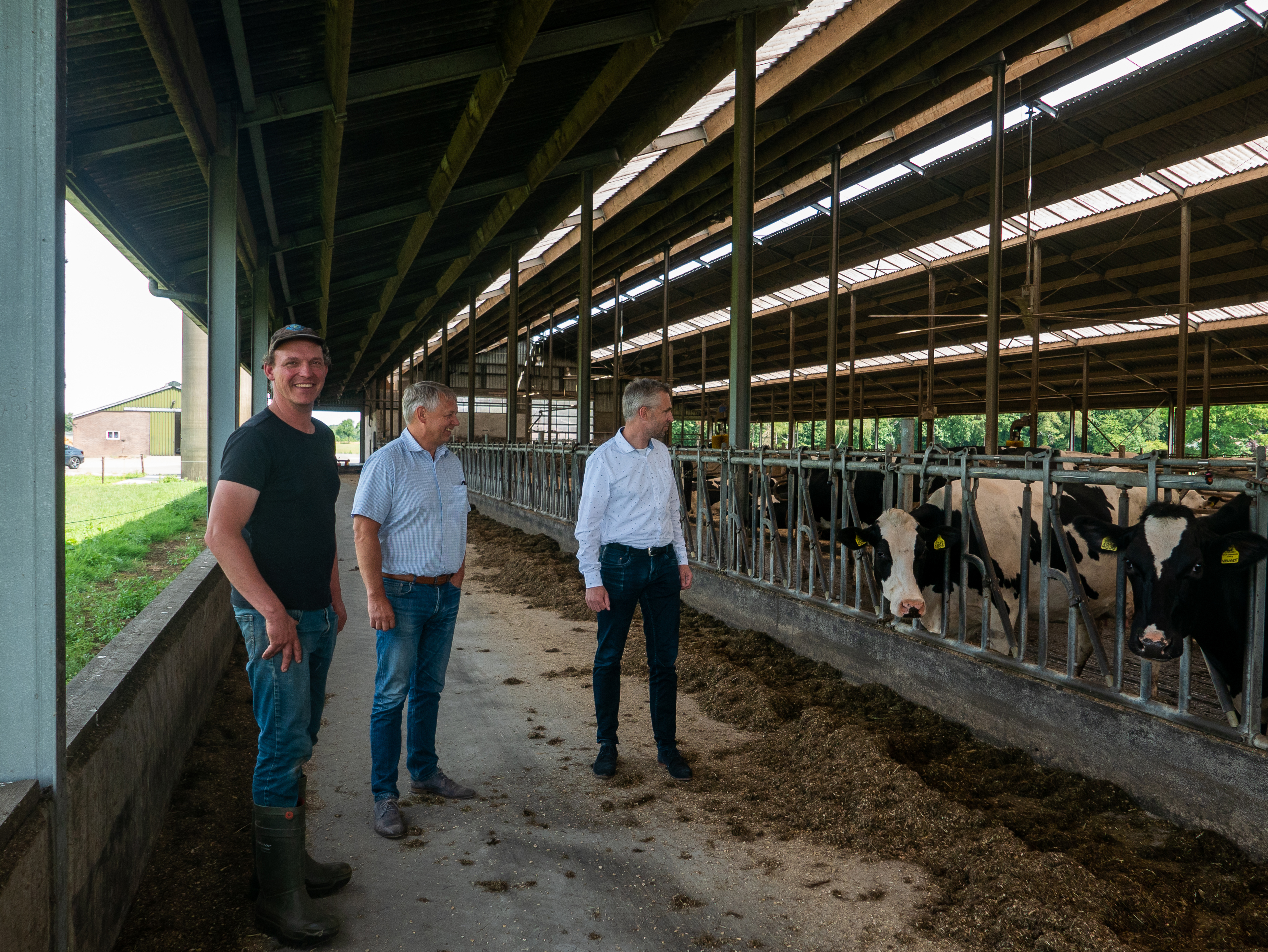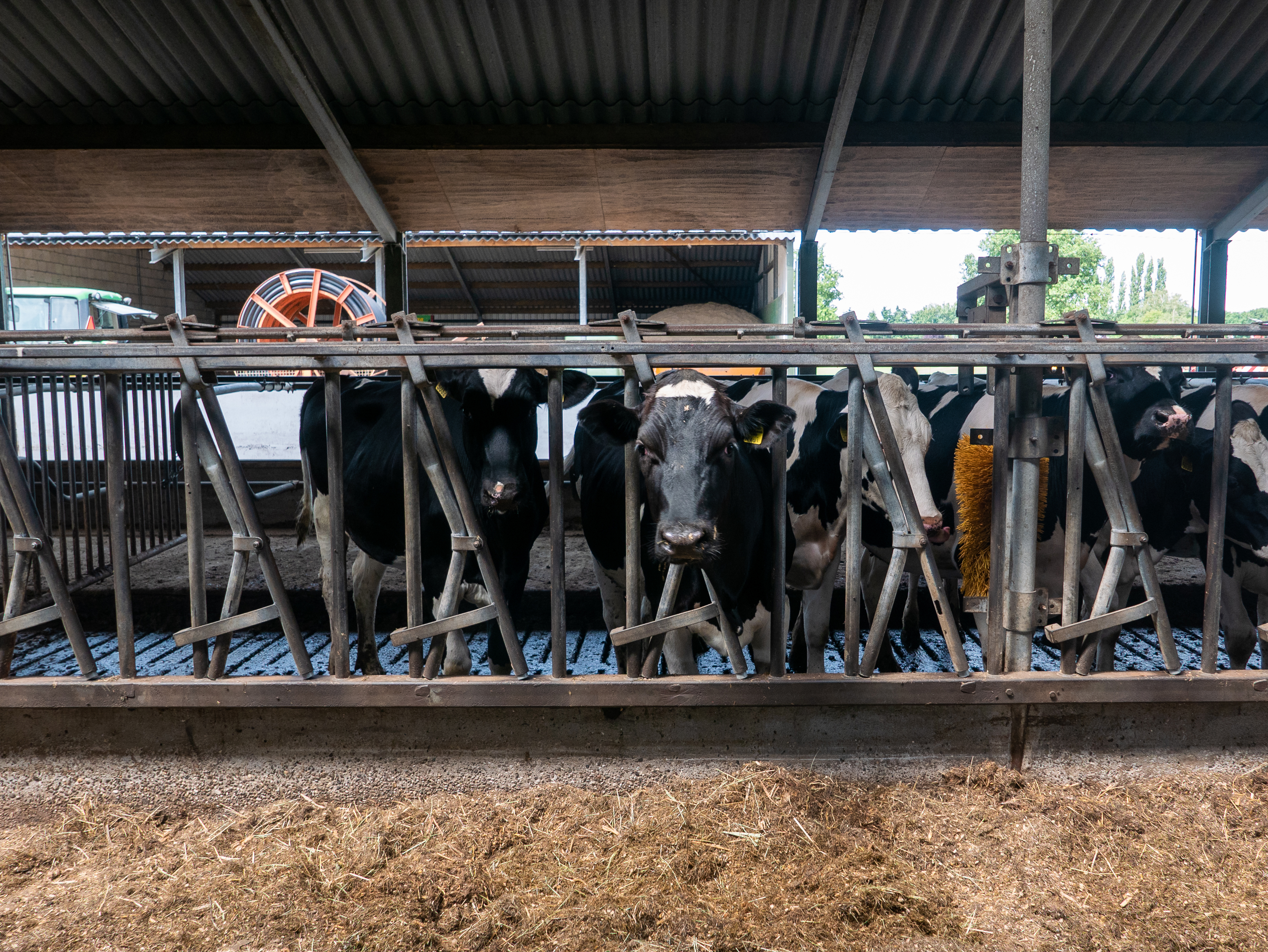© a.s.r. 2025
16 October 2022 | 9 min.
Steward Ronald Kramer and portfolio manager Fadyan Pronk of a.s.r. real estate and farmers Tonny and Rick Berends were interviewed by Change Inc. Read the interview in which they discuss how cooperation and a combination of discounts and subsidies can help farmers tackle the problems.
Climate problems are piling up. This can be seen particularly in agriculture, with Europe now forcing the Dutch government to cut its nitrogen emissions. This problem comes on top of other challenges such as CO2 emissions, loss of biodiversity and poor water quality. Cooperation and a combination of discounts and subsidies can help farmers to tackle the problems. “In the end it's just a calculation,” says farmer Rick Berends.
It is a quiet, summer’s day in a rural area in the east of the Netherlands. Apart from the screeching of birds of prey chasing each other and the occasional sound of a passing car, it is silent. The cows are in the cowshed. “They actually prefer 5 to 10 degrees,” says Tonny Berends. His son Rick runs the farm, but father helps out every day.
A car drives into the farmyard. Two men get out: steward Ronald Kramer and Fadyan Pronk, rural real estate portfolio manager at a.s.r. real estate. The men from a.s.r. will be given a tour of the farmyard, but first they go for a coffee in the office, a room next to the stable with a concrete floor, a small kitchen and a table with chairs around it.
The conversation quickly turns to the challenges farmers face: the nitrogen problem, CO2 emissions, loss of biodiversity and poor water quality. Dutch farmers have a lot on their plate. Berends stresses that responding to changes is part of being an entrepreneur. “If you can’t cope with change, you won't be a farmer for long.” Kramer, the steward, agrees with him. “Indeed, it won’t end well. But policies have changed so often in the last fifteen years.”

From left to right: Rick Berends, Ronald Kramer and Fadyan Pronk | Photo credit: Rianne Lachmeijer
Major landowner
a.s.r. real estate manages 43,000 hectares of land. That makes it one of the largest landowners in the Netherlands. Approximately 6,000 hectares consists of estates and 37,000 hectares comprises agricultural land held by the ASR Dutch Farmland Fund. a.s.r. real estate mainly makes the land available to farmers under long-term leases.
Discount for sustainability measures
Kramer has been coming to see Berends for some time. He helped him with a Young Farmers’ Long Lease scheme when Berends wanted to buy an additional 40 hectares. Berends now leases that land from a.s.r. real estate. With his MDV-certified cowshed (a certification scheme for cowsheds that are more environmentally and animal friendly), solar panels on the roof and less use of fertilisers and chemical pesticides, he is taking steps towards sustainability.
“We have 20 hectares of natural land in the floodplains. Before I start mowing, a birding group looks to see where the corncrake is nesting. We won't mow there before 15 June, because that bird won’t have left yet.”
Rick Berends, Farmer
Because he is taking sustainability measures, Berends is eligible for the sustainability discount that a.s.r. offers on the lease. He found “a lot of things coming together”, as he already had to write a business plan for the Young Farmers’ Long Lease scheme. His soil is well suited to botanical grassland and he already wanted to sign up for Albert Heijn's sustainable milk product: The 'Better for Cow, Nature & Farmer' programme of Royal A-ware. “That means a discount from a.s.r. and a premium on the milk price. It’s a combination that makes you stronger.”
That combination is no coincidence, Pronk explains. “We consulted parties in the supply chain such as Royal A-ware to see how we could work together. It means farmers with us don't have to go through an entire checklist again. If we see that they’re participating in Royal A-ware, that’s all we need to know.” The same applies to organic farmers with a Skal certification. That certificate shows that the farmer's products are organic.
Nature and soil management
Farmers still have to set aside 5 percent of their land for agricultural nature management and participate in the Open Soil Index. “To be able to assess the quality of the soil and water,” Pronk explains. This index also provides recommendations for improvement. Finally, farmers' sustainability steps and plans are reviewed every five years. If they are no longer sufficiently in line with the objective of a.s.r. or if the farmer wants to go in another direction, they can choose to stop. “But if it works to your advantage, you’d be crazy to stop, of course,” Berends replies.
“We sign contracts for periods ranging from 25 to 40 years, but the rules are changing and knowledge of sustainability is also evolving. That’s why the steward meets the farmer every five years to see what the farmer has achieved in the last few years and what sustainability plans there are for further development.”
Fadyan Pronk, Portfolio manager rural real estate
The scheme was introduced last year. Pronk estimates that around 5 percent of farmers are now participating. “We’ve now signed a hundred contracts with a sustainability discount. These are with both existing and new customers, so farmers who’ve had a lease or long lease with us for, say, ten or fifteen years are also eligible. They will then receive a discount for the remaining term. In this way, we also aim to include the existing portfolio in that sustainability battle.”
‘Serious money’
Farmers receive a 10 percent discount for the first three years and a 5 percent discount in the subsequent years. “10 percent in the first three years: that's serious money,” says Kramer.
The scheme is not yet equally attractive to every farmer, however. For example, it is particularly difficult for arable farmers to set aside 5 percent of their land for agricultural nature management. “Every metre you remove from a plot of land means a loss of output, because you can't grow anything there,” Pronk explains. Also, there are fewer schemes that generate extra money per product for sustainability steps. In many cases there are no government subsidies available, for example for a strip of flower-rich grassland around the fields.
Added value for farmers
The added value for farmers lies in the accumulation of discounts, subsidies and higher prices. That makes it worthwhile for them to take sustainability steps. “We’re now working with stewards and arable farmers among our clients to see how we can adjust the discount scheme to make it more suitable for arable farmers too,” says Pronk.
The discount from a.s.r. is one of the things that helps to make agriculture more sustainable, but more is needed. Sitting round the plastic table in Warnsveld, the men believe everything will turn out fine. “I think a balance will be struck, with the farmer able to earn a fair income while benefiting nature,” says Kramer.
“In Brabant there are Peel Nature Villages. Entrepreneurs want to erect tiny houses there in exchange for creating new nature reserves, at a rate of roughly two tiny houses per hectare of new nature reserves. The tiny houses can be grouped near the farmyard or possibly erected 'off grid' in the new forests or herb-rich grasslands. The farmer receives a modest rent and manages the surrounding land, which is ideal for keeping livestock. In this way they can recreate a kind of bocage landscape. It’s an ideal place for a dairy farm, because you can earn something from the bocage landscape and from the rent. It also provides a solution to the housing problem.”
Ronald Kramer, Steward
Innovation and proper arrangements
Kramer believes in a combination of proper arrangements for farmers who already wanted to leave farming and a beneficial redistribution of land among the farmers who continue farming. With rules on nature management. He also believes in innovation, for example in the case of a farm that wants to erect a glass housing around a cowshed to capture methane and turn it into gas. “But that means the cows can no longer go outside.”
Separating manure and urine
He also knows of a machine that separates urine and manure in the cowshed. That machine is in the news a lot, because the manufacturer claims it can reduce nitrogen emissions by up to 70 percent. “That needs to be looked into closely,” says Kramer. If it works, he thinks it could be a good solution. “Then the government could help farmers to finance it. They don't have to give it away free, just provide an interest-free loan, for example.” He thinks it would be cheaper than buying out farmers. But it needs to work. A farmer can’t pay out €150,000 a year on a machine that turns out to be not fit for purpose. “Yes, then you’re stuck,” Berends agrees.
Pronk adds that it is important not to look at problems in isolation. If we tackle nitrogen, CO2 emissions or water quality separately, things could turn out badly. For example, a dairy farmer might purchase an expensive machine to reduce nitrogen, only to have to dispose of cows a few years later due to poor water quality or loss of biodiversity.
Not just the farmer, but the supply chain too
“As a society, we often insist that the farmer should be the one to come up with solutions, but we believe the supply chain as a whole should be involved. The farmer has an important role to play, but so do we as landowners. Just like other parties in the supply chain,” says Pronk.
Kramer adds that nature organisations can also play a role by making land available to farmers. “That’ll happen sooner or later,” Berends believes. “It's a huge job, but we’ve made a start,” he says, standing up. It is time for a tour of the farmyard and a few photos. “Should I put something else on?” Berends asks, looking at his T-shirt and boots. “No, you’re fine. She’ll write that you’re in work clothes," says his father.
Source: https://www.change.inc/agri-food/deze-boer-verandert-het-kan-ook-in-je-voordeel-werken-38936
This interview was written in Dutch. a.s.r. real estate had it translated into English.

Photo credit: Rianne Lachmeijer